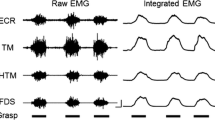Summary
In 10 healthy persons and 40 patients with neurogenic and myogenic lesions the ulnar nerve was stimulated percutaneously by sqare wave impulses and the evoked muscle potentials of the m.abductor digiti V were recorded with two needle electrodes. The intensity of the applied stimulation was gradually reduced from supramaximal to subthreshold levels. “Latency-stimulus strength” relations were evaluated. Both in healthy subjects and in patients the latency of the muscular response is progressively increasing with decreasing stimulus intensity. We suppose that only slower motor nerve fibres are successively excited as the stimulus strength is lowered. Our results show typical “latency-stimulus strength” relations for healthy persons and for patients with peripheral nerve injuries, polyneuropathies, Friedreich's ataxia, neural progressive atrophies, and myasthenia gravis. Analyzing the results of our investigation we conclude that the “latency-stimulus strength” relation reflects the actual state of motor nerve fibres of a particular nerve trunk in different pathological states.
Zusammenfassung
Bei 10 gesunden Kontrollpersonen und 40 Patienten mit neurogenen und myogenen Schädigungen wurde der N. ulnaris percutan mit elektrischen Rechteckimpulsen gereizt und das Potential der Antwort des M. abductor digiti V. mittels Nadelelektroden registriert. Die Intensität des Reizes wurde stufenweise von supramaximal bis zur Reizschwelle herabgesetzt. Das Verhältnis zwischen Reizintensität und Latenz der Muskelzuckung wurde ausgewertet. Sowohl bei Gesunden als auch bei Kranken wachsen die Latenzen der Muskelzuckung bei abnehmender Reizintensität progressiv an. Dies zeigt, daß bei abnehmender Reizintensität sukzessiv immer langsamer leitende Nervenfasern des Muskelnerven erregt werden. Die Ergebnisse unserer Untersuchungen zeigen, daß es typische Latenz-Intensitätskurven für Gesunde und für Kranke mit posttraumatischen Nervenläsionen, Polyneuritis, neuralen progressiven Atrophien (Charcot-Marie-Tooth), Morbus Friedreich und mit Myasthenia gravis pseudoparalytica gibt. Auf Grund der Analyse unserer Resultate schließen wir, daß das Verhältnis zwischen Reizintensität und Latenz der Muskelzuckung den aktuellen Zustand der einzelnen Fasergruppen eines peripheren Nerven bei verschiedenen pathologischen Prozessen anzeigt.
Similar content being viewed by others
Literatur
Bäxt, R., H. Helmholz: Monatsberichte der Königl. Akad. d. Wissenschft. Berlin 1871, S. 184–191.
Hodes, R., I. Gribetz, J. A. Moskowitz, and I. H. Wagman: Low threshold associated with slow conduction velocity. Arch. Neurol. (Chic.) 12, 510–526 (1965).
—, M. G. Larrabee, and W. German: The human electromyogram in response to nerve stimulation and the conduction velocity of motor axones. Arch. Neurol. Psychiat. (Chic.) 60, 340 (1948).
Hopf, H. C.: Untersuchungen über die Unterschiede in der Leitgeschwindigkeit motorischer Nervenfasern beim Menschen. Dtsch. Z. Nervenheilk. 183, 579–588 (1962).
Preswick, G.: Effect of stimulus intensity on motor latency in carpal tunnel syndrome. J. Neurol. Neurosurg. Psychiat. 26, 398–401 (1963).
Author information
Authors and Affiliations
Additional information
Herrn Professor Dr. med. H.Jacob zum 60. Geburtstag gewidmet.
Rights and permissions
About this article
Cite this article
Drechsler, B. Analyse der Leitgeschwindigkeit einzelner motorischer Fasergruppen. Deutsche Zeitschrift f. Nervenheilkunde 195, 19–25 (1969). https://doi.org/10.1007/BF00244127
Received:
Issue Date:
DOI: https://doi.org/10.1007/BF00244127



